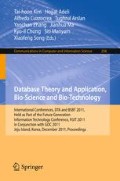Abstract
Many studies have shown that rule-based classifiers perform well in classifying categorical data. However, a limitation of many of them lies in the use of only one measure to select the best attribute-value pair. In this way, many attribute-value pairs have the same best values. Consequently, it is difficulty to distinguish which attribute-value pair is the best.On the other hand, these classifiers usually combine two best attribute-value pairs to generate rules, whether they bias toward the same class label or not. In this paper, we propose a new classification approach named CAIG (Classification based on Attribute-value pair Integrate Gain) which has a number of new features. First, it uses multi measures to select the best attribute-value pairs. Second, it divides attribute-value pairs into different groups according to the class label. Third, it arranges attribute-value pairs to the same groups if they bias to same class label. Fourth, it adopts a greedy algorithm to generate rules from the theses groups. Experimental results show that the method of multi measures is highly accuracy in comparison with the one measure.
Access this chapter
Tax calculation will be finalised at checkout
Purchases are for personal use only
Preview
Unable to display preview. Download preview PDF.
References
Quinlan, J.R.: C4.5: Programs for machine learning. Morgan Kaufmann (1993)
Zhu, W., Wang, F.: Reduction and axiomization of covering generalized rough sets. Information Sciences 152(1), 217–230 (2003)
Zhu, W.: Generalized rough sets based on relations. Information Sciences 177(22), 4997–5011 (2007)
Min, F., Liu, Q., Fang, C.: Rough sets approach to symbolic value partition. International Journal of Approximate Reasoning 49, 689–700 (2008)
Zhu, W.: Relationship among basic concepts in covering-based rough sets. Information Sciences 179(14), 2478–2486 (2009)
Min, F., He, H., Qian, Y., Zhu, W.: Test-cost-sensitive attribute reduction. To Appear in Information Sciences (2011)
Min, F., Liu, Q.: A hierarchical model for test-cost-sensitive decision systems. Information Sciences 179(14), 2442–2452 (2009)
Yao, Y.Y.: Granular computing: basic issues and possible solutions. In: The 5th Joint Conference on Information Sciences, vol. 1, pp. 186–189 (2000)
Yao, J.T., Yao, Y.Y.: A granular computing approach to machine learning (2002), http://www2.cs.uregina.ca/jtyao/Pagers/GrcMining-1534.pdf
Yao, J.T., Yao, Y.Y.: Induction of Classification Rules by Granular Computing. In: Alpigini, J.J., Peters, J.F., Skowron, A., Zhong, N. (eds.) RSCTC 2002. LNCS (LNAI), vol. 2475, p. 331. Springer, Heidelberg (2002)
Liu, B., Hsu, W., Ma, Y.: Integrating classification and association rule mining. In: KDD, pp. 80–86 (1998)
Dong, G., Zhang, X., Wong, L., Li, J.: CAEP: Classification by Aggregating Emerging Patterns. In: Arikawa, S., Nakata, I. (eds.) DS 1999. LNCS (LNAI), vol. 1721, pp. 30–42. Springer, Heidelberg (1999)
Li, W., Han, J., Pei, J.: CMAR: accurate and efficient classification based on multiple class-association rules. In: ICDM, pp. 369–376 (2001)
Cover, T., Hart, P.: Nearest neighbor pattern classification. IEEE Transactions on Information Theory 13, 21–27 (1967)
Dasarathy, B.: Nearest Neighbor Pattern Classification Techniques. IEEE Computer Society Press (1990)
Bian, H.Y.: Fuzzy-rough nearest neighbor classification: an integrated framework. In: Proceedings of IASTED International Symposium on Artificial intelligence and Applications, pp. 160–164 (2002)
Guo, G., Wang, H., Bell, D.A., Bi, Y., Greer, K.: An kNN model-based approach and its application in text categorization. In: Gelbukh, A. (ed.) CICLing 2004. LNCS, vol. 2945, pp. 559–570. Springer, Heidelberg (2004)
Neskovic, P., Cooper, L.N.: Improving nearest neighbor rule with a simple adaptive distance measure. Pattern Recognition 28(2), 21–27 (2007)
Yin, X., Han, J.: CPAR: classification based on predictive association rules. In: SDM, pp. 331–335 (2003)
Quinlan, J.R., Cameron-Jones, R.: FOIL: A Midterm Report. In: Brazdil, P.B. (ed.) ECML 1993. LNCS, vol. 667, pp. 3–20. Springer, Heidelberg (1993)
Cohen, W.: Fast effective rule induction. In: ICML, pp. 115–123 (1995)
Cendrowska, J.: PRISM: An algorithm for inducing modular rules (1988)
Clark, Boswell, R.: Rule induction with CN2:some recent improvements. In: EWSL, pp. 151–163 (1991)
Author information
Authors and Affiliations
Editor information
Editors and Affiliations
Rights and permissions
Copyright information
© 2011 Springer-Verlag Berlin Heidelberg
About this paper
Cite this paper
He, T., Zhou, Z., Huang, Z., Wang, X. (2011). CAIG: Classification Based on Attribute-Value Pair Integrate Gain. In: Kim, Th., et al. Database Theory and Application, Bio-Science and Bio-Technology. BSBT DTA 2011 2011. Communications in Computer and Information Science, vol 258. Springer, Berlin, Heidelberg. https://doi.org/10.1007/978-3-642-27157-1_4
Download citation
DOI: https://doi.org/10.1007/978-3-642-27157-1_4
Publisher Name: Springer, Berlin, Heidelberg
Print ISBN: 978-3-642-27156-4
Online ISBN: 978-3-642-27157-1
eBook Packages: Computer ScienceComputer Science (R0)

